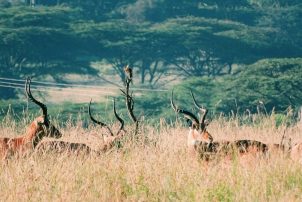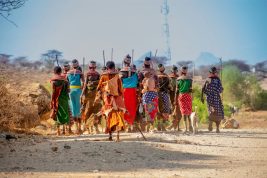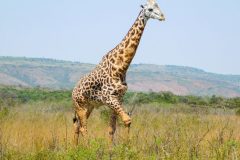Why Visit Tanzania?
Tanzania is a captivating East African nation situated just south of the Equator, renowned as a premier destination for natural wonders, thrilling adventure, and home to the great Mt. Kilimanjaro.
This diverse country is a geographical paradise, boasting everything from vast savannah national parks and lush forests to towering mountains and pristine Indian Ocean beaches. The Tanzanian experience centers on its world-class safari opportunities.
Key highlights include:
- The Serengeti National Park is famous for the spectacular Great Wildebeest Migration.
- The Ngorongoro Crater, a unique, wildlife-rich caldera often called "Africa's Eden," and considered one of the seven wonders of the World.
- Mount Kilimanjaro is the continent's highest peak and the world's largest free-standing mountain.
- The exotic islands of the Zanzibar Archipelago (including Zanzibar and Pemba) offer historical sites and idyllic post-safari relaxation.
Tanzania is also a true birdwatching paradise, attracting enthusiasts with its rich avian diversity.
Formed in 1964 from the merger of Tanganyika and Zanzibar, this nation seamlessly blends wildlife adventure with rich coastal culture. While Dodoma is the designated capital, Dar-es-Salaam remains the country's largest urban center and primary port.
Location of Tanzania
Tanzania is a country of impressive scale and geographical extremes, located on the eastern coast of Africa. Ranked as the 31st largest country in the world, it covers an area of 947,303 square kilometers.
The nation's landscape is incredibly varied. It is home to Mount Kilimanjaro, Africa's towering peak at 5,895 meters, but also encompasses the continent's deepest point in the depths of Lake Tanganyika (1,471 meters below sea level).
Tanzania's borders are shared with nine neighboring countries: Kenya, Uganda, Rwanda, Burundi, Democratic Republic of Congo, Zambia, Malawi, Mozambique, and its eastern edge boasts a 1,424 km Indian Ocean coastline, including the tropical Zanzibar Archipelago.
The country also lays claim to a portion of three of Africa’s Great Lakes (Victoria, Tanganyika, and Nyasa), whose waters are famous for their unique fish species.
From the rugged mountains and forests of the northeast to the extensive plains of the central plateau, Tanzania also features natural wonders such as Kalambo Falls and the Menai Bay Conservation Area, a major marine sanctuary near Zanzibar.
Facts About Tanzania

Tanzania Climate
Tanzania's mainland is a land of climatic and topographical contrasts, generally divided into four main environmental zones.
Geographic and Climatic Zones
The country's distinct areas include:
- Coastal Lowlands: These areas along the Indian Ocean are characterized by a hot and humid climate.
- Central Plateau: This vast region is primarily hot and arid, receiving significantly less rainfall.
- Northern Mountain and Lake Region: Found along the northern border, this zone is home to high elevations, including Mount Kilimanjaro, and borders the Great Lakes.
- Northeastern and Southwestern Highlands: These elevated areas feature climates that range from tropical to temperate.
Tanzania has a generally warm, equatorial climate. Its temperatures are largely dictated by elevation, with higher areas being cooler. Due to its proximity to the equator, the country experiences minimal seasonal shifts in temperature throughout the year, as consistent, high solar radiation keeps conditions stable. Most locations see a mean monthly temperature variation of less than 9°F (5°C). Ground frost is uncommon below an altitude of 8,200 feet (2,500 meters).
Rainfall across Tanzania is distinctly seasonal.
- Arid Regions: Roughly half of mainland Tanzania receives less than 750 mm of annual precipitation, which is generally considered the minimum needed for viable tropical agriculture. The central plateau is even drier, averaging under 510 mm yearly, and experiences only one rainy season running from December to May.
- Coastal Regions: The coast receives significantly more rainfall with two peak rainy periods, one in October-November and another in April-May.

Culture and People
Tanzania is home to an exceptionally diverse population, with over 120 distinct indigenous African ethnic groups. Over time, many of these smaller groups have merged into larger cultural units.
Unfortunately, some of the smallest communities are diminishing due to factors like rural-to-urban migration, modernization, and political changes.
The vast majority of Tanzanians are of Bantu descent. Key Bantu groups include:
- Sukuma: The largest Bantu group, primarily residing in the northern region, south of Lake Victoria.
- Nyamwezi: Found in the west-central part of the country.
- Hehe: Located in the southern highlands.
- Haya: Inhabiting the northwest corner.
- Chaga (or Chagga): Reside on the southern slopes of Mount Kilimanjaro.
- Makonde: Located in the southeastern Mtwara and Ruvuma regions.
- Zaramo: A largely urbanized group, concentrated in and around Dar es Salaam and the coastal areas.
Besides the Bantu majority, Nilotic peoples form another significant population segment, primarily in the north-central mainland. These include the Maasai, Arusha, Samburu, and Baraguyu.
At the other end of the spectrum, the Zanaki represent the smallest ethnic group, located near Musoma in the Lake Victoria region. Notably, Tanzania's revered founding father and first president (1962–1985), Julius Nyerere, was from the Zanaki community

Is Tanzania Safe?
Tanzania is widely regarded as a safe and stable destination for tourists, which is crucial given that the tourism sector is a major source of the country's foreign revenue.
The local authorities place a high priority on maintaining security for visitors. The nation also enjoys remarkable political stability within the East African region, and its citizens are known for their warm and welcoming demeanor.
Best Tanzania-Uganda Tour Packages
Check out these popular safaris in Tanzania! They're just a few examples of what you can do. You can use these plans to get ideas or start planning. When you're ready, reach out to us, and our team of experts will help you create the perfect safari experience for you
Most Popular Safari Destinations in Tanzania.
Tailor-Made Safari
Plan your own safari! You get to decide what you want to do, whether it's gorilla trekking, wildlife drives, boat safaris, cultural visits, or nature hikes. You can even extend your trip to Rwanda, Kenya, or Uganda. We'll help you choose the best accommodations for a memorable experience.

